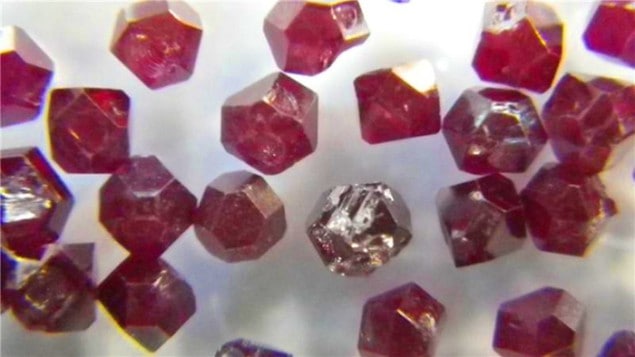
An international group of researchers has developed a nanodiamond biosensor that can determine the iron content in blood. The sensor uses defects in the tiny diamonds to detect a particular protein that stores iron in the blood and which is also found in many types of living organisms. The researchers hope to extend their sensor technology to allow it to detect other proteins.
Iron abounds in most living organisms – and proteins containing the metal are found in everything from single-celled micro-organisms to human beings. In humans, iron deficiencies are mainly caused by malnutrition and can lead to anaemia, while an increased level of iron can indicate the presence of an acute inflammatory response. So, accurately measuring blood-iron levels is an essential medical diagnostic tool.
Distinct detection
Detecting specific single proteins in biological samples is no mean feat, however. Current methods either involve using organic markers – dyes and fluorescent proteins – or quantum dots. But the markers tend to bleach after being used for a while and quantum dots can degrade the sample. Standard blood tests involve detecting a protein, known as ferritin, which is responsible for the storage and transport of iron and can contain up to 4500 magnetic iron ions. But thanks to the use of the organic dyes or the quantum dots, the results can be inconclusive, as they indirectly infer the iron amounts.
Now, a team led by physicist Fedor Jelezko at Ulm University in Germany, along with colleagues in Taiwan, has developed a method to detect ferritin using nanometre-sized diamonds that contain lattice imperfections known as nitrogen-vacancy (NV) defects. These defects occur when two neighbouring carbon atoms in the diamond are replaced by a nitrogen atom and an empty lattice site. Such NV sites are capable of detecting weak magnetic fields. This was precisely what the researchers were looking for, as each ferritin-bound iron atom generates a tiny magnetic field that is normally hard to measure.
Special sites
Jelezko told physicsworld.com that the NV sites were crucial for developing the new sensor. This is why the Ulm researchers paired up with Huan-Cheng Chang and colleagues at the Academia Sinica in Taiwan, who irradiated commercially available nanodiamonds with heavy ions to create the NVs.
Stellar spectrum
As a proof-of-principle test the researchers used the nanodiamonds to detect a sample of purified ferritin protein rather than a sample still in the blood. To do this, Jelezko and colleagues had to find a way to adsorb the ferritin onto the diamond’s surface. This was done using electrostatic interactions between the nanodiamonds and ferritin proteins that result in a non-covalent bond being formed between the diamond surface and an amino group in the protein. The researchers then detected the ferritin via the “magnetic noise” that is generated by the iron atoms in the protein constantly flipping their unstable magnetic moments.
“We essentially measure the amplitude of the magnetic noise at the NV sites,” says Jelezko. He also points out that while in most experiments noise of any kind is a hindrance, in this case it is crucial. “In fact, we detect not just the amplitude, but also the frequency and hence the spectrum of the noise,” Jelezko says. He further explains that the researchers can use their results to calculate the number of atoms that are responsible for the noise – the more atoms, the higher the frequency of the flips. Jelezko likens the technique to astronomy, where the spectrum of a star reveals its composition and inner processes. “We don’t touch the iron inside the protein, we measure the noise coming out instead and so we have a non-contact technique,” he says.
Direct sensing
The team observed a significant reduction in both coherence and relaxation time of the spin of an NV caused by the presence of ferritin – in fact, the observed effect was large enough for a single ferritin molecule close to the sensor to be detected. The researchers also used a theoretical model to validate the method, to ensure that the signals they measured were consistent with the presence of ferritin.
The new work shows that NV biosensors are a promising development thanks to their biocompatibility and high magnetic sensitivity at ambient conditions. Jelezko says that the method could soon be used to detect iron in blood samples directly, by simply placing the nanodiamond in a blood sample and then washing away all but the ferritin, or by creating a microfluidic channel in the diamond to send the sample through. He also thinks that clinical trials with actual blood samples could be carried out easily, especially thanks to the fact that only a tiny sample would be required. For now, the team is looking at other proteins and substances in blood that could be detected using the sensor.
The research is published in Nano Letters.



